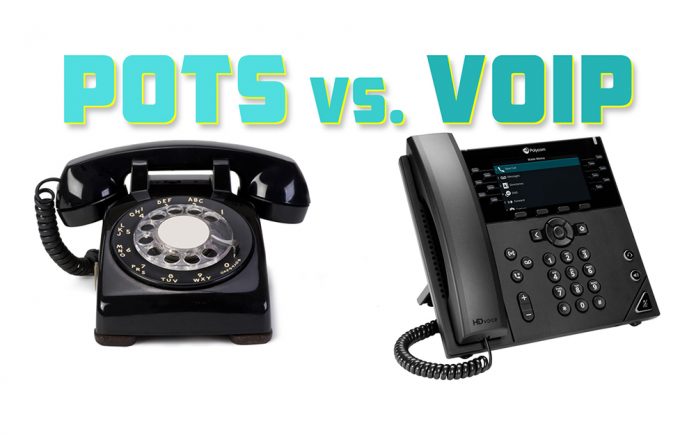
The Differences and the Advantages…
By Dennis Shelly
Today’s business phones are more than just equipment for making or receiving calls. Telephone systems today are far more advanced and have a variety of extra functions than their predecessors. VOIP versus POTS is a comparison of the two telephone systems based on a variety of criteria. While both POTS (Plain Old Telephone Service) and VoIP (Voice over Internet Protocol) have their advantages and disadvantages and may be appropriate depending on your organization’s needs. In most circumstances, employing VoIP (or Hosted VoIP) is less expensive than traditional Analog Phone lines such as POTS. To begin, it is important to comprehend the differences between the two and what each offers at the business level. But, before we get into the VOIP vs POTS debate, let’s take a closer look at each service.
Plain Old Telephone Service (POTS)
POTS is an abbreviation for Plain Old Telephone Service, which refers to the traditional telephone system in which analog speech transmission occurs via copper twisted pair wires. Also known as the Public Switched Telephone Network (PSTN), It is an old and basic mode of communication. It is typically limited to 52 kbps and supports bidirectional or full-duplex voice band connections. In all of its existence, the POTS system has had little change or upgrade. Even today, a copper phone line creates a dedicated circuit between two places during transmission. While the operator no longer connects the two parties manually, automated switching operates on a similar basic concept.
POTS Advantages:
- Since its inception, analog telephone technology has seen significant evolution. It is a well-established concept with a solid core platform that is supported by a global network of wires linking even the most remote of locales.
- Analog endpoints may not always be important, but for the time being, the technology is well known and is seen as a preferable means of voice communication, even in commercial settings.
- POTS, or landline, is one of the simplest services to set up. When it comes to installation and operation, this 2-wire telephone service is simple. However, this is also because it lacks the features of modern internet-based voice communication.
- POTS has a distinct benefit over VoIP in that the phone can continue to function even if power is lost. This is because the power to the landline is supplied directly by the carrier rather than the end-user. As a result, even if your building loses electricity due to a storm or other unforeseen events, the telephone connection can continue to function, which is especially beneficial in an emergency.
- Even today, POTS is a popular means of communication for a variety of applications. Elevator lines, fax lines, and, most crucially, emergency phone line services are examples of these.
VoIP (Voice Over Internet Protocol):
VoIP refers to voice over internet protocol, as opposed to traditional phone lines. IP telephony, or Internet telephony, is another name for it. VoIP is a phone service that is provided via the internet. It turns speech signals into digital signals and transmits them as a packet through Internet Protocol (IP) networks. Simply said, Voice over IP technology enables us to make and receive phone calls via the internet. The internet is used as the transmission medium for VoIP phone calls. It is also known as Voice – Over – Internet (VOI).
A hosted PBX (Private Branch Exchange) is often used to set up a VoIP service. Currently, are also being utilized to set up VoIP phone services. Moreover, the service is available with an on-premises PBX system. SIP trunking is used to enable VoIP phone service in such systems. Because the VoIP phone system is fully reliant on internet access, it is critical to ensure that internet connectivity is consistent, with no disruptions in connections, and that latency and packet loss is kept to a minimum. Typically, for small offices, a minimum of 5 Mbps upload, and download is recommended to ensure voice quality of service.
VoIP Advantages:
- VoIP telephone systems are more versatile since they can integrate with other business applications such as email, CRM, and so on. This increases overall productivity because the firm can manage all of its processes using the phones in a single place.
- VoIP’s flexibility and mobility are comparable to that of mobile phone users. Employees do not need to be physically present in their offices to answer calls or access the system. Such qualities enable employees to be productive regardless of where they work.
- Every add-on feature in traditional analog telephone installations comes at a cost. In the case of VoIP, additional services such as voicemail-to-email, voicemail-to-text, auto-attendants, call forwarding, call transfers, DND capabilities, and so on are typically included in the package.
- VoIP ensures that your company does not incur new equipment or call volume-related expenses as its requirements grow.
One of the primary reasons why some businesses are reluctant to use VoIP is that new technology might make people perceive it as a complicated thing. While POTS may appear to be easier to use, VoIP does have a learning curve. However, VoIP’s support for business development and expansion surpasses the convenience of older analog telephone systems. Furthermore, newer technology like VoIP is gradually replacing older systems, making it harder for users to get replacement parts or upgrade their existing equipment. Finally, one of the primary reasons why businesses are choosing VoIP through business internet access rather than traditional analog phone lines is cost. In this case, newer is superior in every way.
Considering upgrading your business communications solution or have a question regarding VOIP technology? Our Eggsperts are standing by to help. Please contact us by calling (760) 205-0105 or emailing us at tech@eggheadit.com with your questions or suggestions.
IT | Networks | Phones | Security | Audio/Video









































